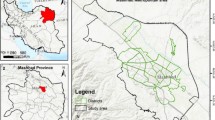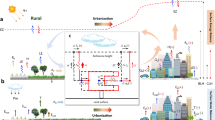Abstract
Critical to effective urban climate adaptation is a clearer understanding of the sensitivities of resource demand to changing climatic conditions and land cover situations. We used Bayesian Maximum Entropy (BME) stochastic procedures to estimate temperature and precipitation at the very small scale of urban Census Block Groups (CBGs) in Phoenix, Arizona and Portland, Oregon, and then compared average household water use patterns by climate conditions and land cover characteristics between and within the two cities. Summer household water use was positively related to maximum temperatures and dense vegetation cover in terms of grass cover and trees and shrubs; it was negatively related to precipitation amounts in both cities. Water use was more sensitive to maximum temperature, precipitation levels, and vegetation cover in Phoenix than in Portland. There was substantial intra-city variation with greater sensitivity in urban water use associated with higher densities of trees and shrubs in both cities, but in Phoenix, the highest sensitivities to maximum temperatures occurred in CBGs with the most grass cover while in Portland, high sensitivity was associated with CBGs with the least grass cover. Many of the latter are in highly built-up downtown areas of Portland where artificial irrigation is required to maintain landscapes during the hot summer season. Take-home messages are: (1) BME space/time statistics provide efficient estimates of missing precipitation and temperature data to create continuous high resolution meteorological data that improve water demand analysis and (2) use of landscaping for urban climate adaptation will have differing impacts on water use, depending on local climate conditions, urban layout, and the type of vegetation cover.





Similar content being viewed by others
References
Aggarwal RM, Guhathakurta S, Grossman-Clarke S, Lathey V (2012) How do variations in Urban Heat Islands in space and time influence household water use? The case of Phoenix, Arizona. Water Resour Res 48(6):W06518
Allshouse WB, Pleil JD, Rappaport SM, Serre ML (2009) Mass fraction spatiotemporal geostatistics and its application to map atmospheric polycyclic aromatic hydrocarbons after 9/11. Stoch Environ Res Risk Assess 23:1213–1223
Balling RC, Gober P (2007) Climate variability and residential water use in the city of Phoenix, Arizona. J Appl Meteorol Climatol 46:1130–1137
Balling RC, Gober P, Jones N (2008) Sensitivity of residential water consumption to variations in climate: an intraurban analysis of Phoenix, Arizona. Water Resour Res. 44(10):W10401
Bogaert P (2002) Spatial prediction of categorical variables: the Bayesian maximum entropy approach. Stoch Environ Res Risk Assess 16:425–448
Breyer B, Chang H (2014) Urban water consumption and weather variation in the Portland, Oregon metropolitan area. Urban Clim 9:1–18
Breyer B, Chang H, Prandvash H (2012) Land-use, temperature and single family residential water use patterns in Portland, Oregon and Phoenix, Arizona. Appl Geogr 35:142–151
Bureau of the Census (2014) Highest population density in the largest US cities
Chang H, Parandvash GH, Shandas V (2010) Spatial variations of single-family residential water consumption in Portland, Oregon. Urban Geogr 31(7):953–972
Chang H, Praskievicz S, Parandvash GH (2014) Sensitivity of urban water consumption to weather and climate variability at multiple temporal scales: The case of Portland, Oregon. Int J Geospat Environ Res 1(1) Article 7
Christakos G (2000) Modern spatiotemporal geostatistics. Oxford University, New York
Christakos G, Bogaert P, Serre ML (2002) Advanced functions of temporal GIS. Springer-Verlag, New York
City of Portland Bureau of Environmental Services (2012) City of Portland HYDRA Rainfall Network. http://or.water.usgs.gov/non-usgs/bes/. Accessed 31 Dec 2014
Coomes P, Rockaway T, Rivard J, Kornstein B (2010) North America residential water usage trends since 1992. Water Research Foundation, Denver, CO
D’Or D, Bogaert P, Christakos G (2001) Application of the BME approach to soil texture mapping. Stoch Environ Res Risk Assess 15:87–100
Gober P, Brazel A, Quay R, Myint S, Grosman-Clarke S, Miller A, Rossi S (2010) Using watered landscapes to manipulate urban heat island effects. J Am Plann Asssoc 76(1):109–121
Gober P, Middel A, Brazel A, Myint S, Chang H, Duh J, House-Peters L (2012) Tradeoffs between water conservation and temperature amelioration in Phoenix and Portland: Implications for urban sustainability. Urban Geogr 33(7):1030–1054
Gober P, Larson K, Quay R, Polsky C, Chang H, Shandas V (2013) Why land planners and water managers don’t talk to one another and why they should! Soc Nat Resour 26(3):356–364
Guhathakurta S, Gober P (2007) The impact of the Phoenix urban heat island on residential water use. J Am Plann Assoc 73(3):317–329
Guhathakurta S, Gober P (2010) Residential land use, the urban heat island, and water use in Phoenix: a path analysis. J Plan Edu Res 30(1):40–51
Halper EB, Scott CA, Yool SR (2012) Correlating vegetation, water use and surface temperature in a semi-arid city: a multiscale analysis of the impacts of irrigation by single-family residences. Geogr Anal 44(3):235–257
Hart M, Sailor DJ (2008) Quantifying the influence of land-use and surface characteristics on spatial variability in the urban heat island. Theor Appl Clim 95:397–406
Highest Population Density in the United States in the Largest Cities (2014) Last accessed on April 15 2014 http://www.biggestuscities.com/demographics/us/population-density-by-top-100-city
Hong C, Chang H (2014) Uncovering the influence of household sociodemographic and behavioral characteristics on summer water consumption in the Portland Metropolitan Area. Int J Geospat Environ Res 1(2), Article 2
House-Peters L, Chang H (2011a) Modeling the impact of land use and climate on neighborhood-scale evaporation and nighttime cooling: a surface energy balance approach. Landsc Urban Plan 103:139–155
House-Peters L, Chang H (2011b) Urban water demand modeling: review of concepts, methods, and organizing principles. Water Resour Res 47:W05401
House-Peters L, Pratt B, Chang H (2010) Effects of urban spatial structure, sociodemographics, and climate on residential water consumption in Hillsboro, Oregon. J Am Water Res Assoc 46(3):461–472
Hwang Y, Clark MP, Rajagopalan B (2011) Use of daily precipitation uncertainties in streamflow simulation and forecast. Stoch Environ Res Risk Assess 25:957–972
Jenerette GD, Harlan SL, Stefanov WL, Martin CA (2011) Ecosystem services and urban heat riskscape moderation: water, green spaces, and social inequality in Phoenix, USA. Ecol Appl 21:2637–2651
Lee SJ, Balling RC, Gober G (2008) Bayesian maximum entropy mapping and soft data problem in urban climate research. Ann Assoc Am Geogr 98(2):309–322
Lee SJ, Wentz EA, Gober P (2010) Space-time forecasting using soft geostatistics: a case study in forecasting municipal water demand for Phoenix, Arizona. Stoch Environ Res Risk Assess 24:283–295
Li L, Xu C-Y (2014) The comparison of sensitivity analysis of hydrological uncertainty estimates by GLUE and Bayesian method under the impact of precipitation errors. Stoch Environ Res Risk Assess 29:491–504
Li L, Xu C-Y, Zhang Z, Jain SK (2014) Validation of a new meteorological forcing data in analysis of spatial and temporal variability of precipitation in India. Stoch Environ Res Risk Assess 28:239–252
March H, Sauri D (2010) The suburbanization of water scarcity in the Barcelona Metropolitan region: sociodemographic and urban changes influencing domestic water consumption. Prof Geogr 62:32–45
Metro Data Resource Center (2008) 2007 High resolution land cover—shapefile version
Middel A, Brazel A, Gober P, Myint SW, Chang H, Duh J-D (2011) Land cover, climate, and the summer surface energy balance in Phoenix, AZ, and Portland, OR. Int J Climatol, doi: 10.1002/joc.2408
Modis K, Vatalis K, Papantonopoulos G, Sachanidis Ch (2010) Uncertainty management of a hydrogeological data set in a greek lignite basin, using BME. Stoch Environ Res Risk Assess 24:47–56
Myint W, Gober P, Brazel A, Grossman-Clark S, Weng Q (2011) Per-pixel versus object-based classification of urban land cover extraction using high spatial resolution imagery. Remote Sen Environ 115(5):1145–1161
National Climatic Data Center (2012). http://www.ncdc.noaa.gov/. Accessed 31 Dec 2014
Runfola DM, Polsky C, Nicolson C, Giner NM, Pontius RG, Krahe J, Decatur A (2013) A growing concern? Examining the influence of lawn size on residential water use in suburban Boston, MA, USA. Landsc Urban Plan 119:113–123
Serre ML, Christakos (1999) Modern geostatistics: computational BME analysis in the light of uncertain physical knowledge—the Equus Beds study. Stoch Environ Res Risk Assess 13:1–26
Serre ML, Christakos G, Miller CT (2003) A BME solution of the inverse problem for saturated groundwater flow. Stoch Environ Res Risk Assess 17:354–369
Shashua-Bar L, Pearlmutter D, Erell E (2009) The cooling efficiency of urban landscape strategies in a hot dry climate. Landsc Urban Plan 92:179–186
Shashua-Bar L, Pearlmutter D, Erell E (2011) The influence of trees and grass on outdoor thermal comfort in a hot-arid environment. Int J Climatol 31:1498–1506
Sivajumar B (2011) Global climate change and its impacts on water resources planning and management: assessment and challenges. Stoch Environ Res Risk Assess 25:583–600
Stone B and Norman JM (2006) Land use planning and surface heat island information: a parcel-based radiation flux approach. Atmos Environ 40:3561–3573
US Geological Survey (2012) National Elevation Dataset available at http://ned.usgs.gov/ (Accessed 25 May 2014)
Wentz EA, Gober P (2007) Factors influencing water consumption for the City of Phoenix, Arizona USA. Water Resour Manag 21:1849–1863
Xu J, Chen Y, Li W, Nie Q, Hong Y, Yang Y (2013) The nonlinear hydro-climatic process in the Yarkand River, northwestern China. Stoch Environ Res Risk Assess 27:389–399
Acknowledgments
Financial assistance for this Sector Applications Research Program (SARP) project was provided by the Climate Program Office of the U.S. Department of Commerce, National Oceanic and Atmospheric Administration (NOAA) pursuant to NOAA Award No. NA09OAR4310140. Additional financial support was provided by the National Science Foundation through the Decision Center for a Desert City (SES-0345945) and the James F. and Marion L. Miller Foundation sustainability Grant. The statements, findings, conclusions, and recommendations expressed in this material are those of the research team and do not necessarily reflect the views of NOAA, US Department of Commerce, the National Science Foundation, or the US Government. The authors also wish to thank Adam Q. Miller, Water Resources Planner at the City of Phoenix, for help with the City of Phoenix water data. We also appreciate Sally Wittlinger who created the base map of the study area.
Author information
Authors and Affiliations
Corresponding author
Rights and permissions
About this article
Cite this article
Lee, SJ., Chang, H. & Gober, P. Space and time dynamics of urban water demand in Portland, Oregon and Phoenix, Arizona. Stoch Environ Res Risk Assess 29, 1135–1147 (2015). https://doi.org/10.1007/s00477-014-1015-z
Published:
Issue Date:
DOI: https://doi.org/10.1007/s00477-014-1015-z




